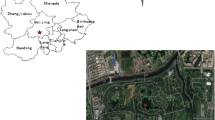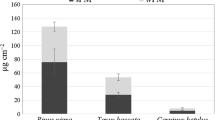Abstract
Vegetation collection is one of the most effective scavenging methods but relevant studies are limited. It can be described by some abstract parameters such as collection rates and deposition fluxes within the canopy. In order to estimate the dry deposition within the canopy of particular matters (PMs) in Beijing, a highly particle-polluted city, and reveal the PM pollution-removal abilities of plants in wetlands and forests, concentration and meteorological data were collected during the daytime in an artificial forest and a wetland in the Olympic Park in Beijing. The dry depositions within the canopy and vegetation collection rates were calculated by a well-developed model and validated by measured deposition fluxes in 11 random experiment days. The experiment year was divided into three plant growth stages based on canopy density, and the day was divided into four different times. Two heights, 10 and 1.5 m, were defined in the forest while in the wetland, 0.5 and 1.5 m were defined. The results showed that in Beijing, the most severe pollution by PMs occurs in the non-leaf stage (NS), and the full-leaf stage (FS) is the cleanest stage. In NS, namely winter, more fossil fuel was used for worms in Beijing and peripheral areas and this might be the reason for the serious pollution condition. Within the canopy, PM deposition fluxes in the wetland are more than those in the forest, but the vegetation collection rates of the forest are higher. The lower temperature conditions led to more dry deposition, and the larger canopy contributed to the higher collection rates. During the daytime, over the year, the deposition of PM10 in three plant growth stages is NS ≥ half-leaf stages (HS) ≥ FS, whereas the deposition of PM2.5 is NS ≥ FS ≥ HS, and during the daytime, the maximum deposition fluxes occur in 6:00–9:00 in the wetland while the minimum deposition values occur in 15:00–18:00. This phenomenon was related to the temporal variation of particle concentration.







Similar content being viewed by others
Abbreviations
- PM:
-
particulate matter
- NS:
-
No-leaf stage
- HS:
-
Half-leaf stage
- FS:
-
Full-leaf stage
- PM2.5 :
-
Particles with diameter smaller the 2.5 μm
- PM10 :
-
Particles with diameter between 2.5 and 10 μm
References
Bache DH (1979) Particle transport within plant canopies—I. A framework for analysis. Atmos Environ (1967) 13(9):1257–1262
Bache DH, Sayer W (1975) Transport of aerial spray: I. A model of aerial dispersion. J Agric Meteorol 15(2):257–271
Baumgardner D, Varela S, Escobedo FJ, Chacalo A, Ochoa C (2012) The role of a peri-urban forest on air quality improvement in the Mexico City megalopolis. Environ Pollut 163:174–183
Beckett KP, Freer-Smith PH, Taylor G (1998) Urban woodlands: their role in reducing the effects of particulate pollution. Environ Pollut 99(3):347–360
Croxford B, Penn A, Hillier B (1996) Spatial distribution of urban pollution: civilizing urban traffic. Sci Total Environ 189:3–9
Derwent RG (1996) EPAQS recommendations—can they be implemented. Paper presented at the Proceedings of the 63rd National Society for Clean Air Environmental Protection Conference and Exhibition. National Society for Clean Air, Brighton
Directive C (1999) Council Directive 1999/30/EC of 22 April 1999 relating to limit values for sulphur dioxide, nitrogen dioxide and oxides of nitrogen, particulate matter and lead in ambient air. Official Journal L 163(29/06):0041–0060
Draaijers G, Van Ek R, Bleuten W (1994) Atmospheric deposition in complex forest landscapes. Bound-Layer Meteorol 69(4):343–366
Dzierżanowski K, Popek R, Gawrońska H, Sæbø A, Gawroński SW (2011) Deposition of particulate matter of different size fractions on leaf surfaces and in waxes of urban forest species. Int J Phytoremediat 13(10):1037–1046
Erisman JW, Draaijers GP (1995) Atmospheric deposition: in relation to acidification and eutrophication. Elsevier
Erisman JW, Draaijers G (2003) Deposition to forests in Europe: most important factors influencing dry deposition and models used for generalisation. Environ Pollut 124(3):379–388
Escobedo FJ, Nowak DJ (2009) Spatial heterogeneity and air pollution removal by an urban forest. Landscape Urban Plan 90(3–4):102–110
Freer-Smith PH, El-Khabit AA, Taylor G (2004) Capture of particulate pollution by trees: a comparison of species typical of semi-arid areas (Ficus nitida and Eucalyptus globulus) with European and North American species. Water Air Soil Pollut 155:173–187
Giorgi F (1986) A particle dry-deposition parameterization scheme for use in tracer transport models. Journal of Geophysical Research: Atmospheres (1984–2012) 91(D9):9794–9806
Grönholm T, Aalto PP, Hiltunen V, Rannik Ü, Rinne J, Laakso L, Hyvönen S, Vesala T, Kulmala M (2007) Measurements of aerosol particle dry deposition velocity using the relaxed eddy accumulation technique. Tellus B 59(3):381–386
Hicks BB (2006) Dry deposition to forests—on the use of data from clearings. Agric For Meteorol 136(3):214–221
Horváth L (2003) Dry deposition velocity of PM2.5 ammonium sulfate particles to a Norway spruce forest on the basis of S- and N-balance estimations. Atmos Environ 37(31):4419–4424
Huang R, Zhang Y, Bozzetti C, Ho K, Cao J, Han Y, Daellenbach KR, Slowik JG, Platt SM, Canonaco F, Zotter P, Wolf R, Pieber SM, Bruns EA, Crippa M, Ciarelli G, Piazzalunga A, Schwikowski M, Abbaszade G, Schnelle-Kreis J, Zimmermann R, An Z, Szidat S, Baltensperger U, Haddad IE, Prévôt ASH (2014) High secondary aerosol contribution to particulate pollution during haze events in China. Nature 514(7521):218–222
Jouraeva VA, Johnson DL, Hassett JP, Nowak DJ (2002) Differences in accumulation of PAHs and metals on the leaves of Tiliaxeuchlora and Pyrus calleryana. Environ Pollut 120(2):331–338
Katul GG, Grönholm T, Launiainen S, Vesala T (2011) The effects of the canopy medium on dry deposition velocities of aerosol particles in the canopy sub-layer above forested ecosystems. Atmos Environ 45(5):1203–1212
Kumar R, Kumari KM, Srivastava SS (2006) Field measurements of aerosol particle dry deposition on tropical foliage at an urban site. Environ Sci Technol 40(1):135–141
Kumar R, Rani A, Kumari KM, Srivastava SS (2005) Atmospheric dry deposition to marble and red stone. J Atmos Chem 50(3):243–261
Kumar R, Rani A, Singh SP, Kumari KM, Srivastava SS (2002) Measurements of dry deposition of gaseous and particulate sulphur on marble at a suburban site. Indian J Radio Space Phys 31(2):88–92
Kumar R, Srivastava SS, Kumari KM (2008) Modeling dry deposition of S and N compounds to vegetation. Indian J Radio Space Phys 37(4):272–278
Liu J, Mo L, Zhu L, Yang Y, Liu J, Qiu D, Zhang Z, Liu J (2016a) Removal efficiency of particulate matters at different underlying surfaces in Beijing. Environ Sci Pollut R 23(1):408–417
Liu J, Zhu L, Wang H, Yang Y, Liu J, Qiu D, Ma W, Zhang Z, Liu J (2016b) Dry deposition of particulate matter at an urban forest, wetland and lake surface in Beijing. Atmos Environ 125:178–187
Lo AK, Zhang L, Sievering H (1999) The effect of humidity and state of water surfaces on deposition of aerosol particles onto a water surface. Atmosphere Environment 33:4727–4737
Mammarella I, Rannik Ü, Aalto P, Keronen P, Vesala T, Kulmala M (2011) Long-term aerosol particle flux observations. Part II: particle size statistics and deposition velocities. Atmos Environ 45(23):3794–3805
Matsuda K, Fujimura Y, Hayashi K, Takahashi A, Nakaya K (2010) Deposition velocity of PM2. 5 sulfate in the summer above a deciduous forest in central Japan. Atmos Environ 44(36):4582–4587
McDonald AG, Bealey WJ, Fowler D, Dragosits U, Skiba U, Smith RI, Donovan RG, Brett HE, Hewitt CN, Nemitz E (2007) Quantifying the effect of urban tree planting on concentrations and depositions of PM10 in two UK conurbations. Atmos Environ 41(38):8455–8467
Nowak DJ, Crane DE, Stevens JC (2006) Air pollution removal by urban trees and shrubs in the United States. Urban For Urban Gree 4(3–4):115–123
Ould-Dada Z (2002) Dry deposition profile of small particles within a model spruce canopy. Sci Total Environ 286(1):83–96
Peters K, Eiden R (1992) Modelling the dry deposition velocity of aerosol particles to a spruce forest. Atmos Environ Part A 26(14):2555–2564
Petroff A, Mailliat A, Amielh M, Anselmet F (2008) Aerosol dry deposition on vegetative canopies. Part I: review of present knowledge. Atmos Environ 42(16):3625–3653
Pryor SC, Barthelmie RJ (2000) Particle dry deposition to water surfaces: processes and consequences. Mar Pollut Bull 41(1–6):220–231
Qiu D, Liu J, Zhu L, Mo L, Zhang Z (2015) Particulate matter assessment of a wetland in Beijing. J Environ Sci 36:93–101
Reinap A, Wiman BLB, Svenningsson B, Gunnarsson S (2009) Oak leaves as aerosol collectors: relationships with wind velocity and particle size distribution. Experimental results and their implications. Trees 23(6):1263–1274
Ruijgrok W, Tieben H, Eisinga P (1997) The dry deposition of particles to a forest canopy: a comparison of model and experimental results. Atmos Environ 31(3):399–415
Santosh KP (2012) Ecological effect of airborne particulate matter on plants. Environ Skept Crit 1
Shan Y, Jingping C, Liping C, Zhemin S, Xiaodong Z, Dan W, Wenhua W (2007) Effects of vegetation status in urban green spaces on particle removal in a street canyon atmosphere. Acta Ecol Sin 27(11):4590–4595
Slinn WGN (1982) Predictions for particle deposition to vegetative canopies. Atmospheric Environment (1967) 16(7):1785–1794
Sun F, Yin Z, Lun X, Zhao Y, Li R, Shi F, Yu X (2014) Deposition velocity of PM2.5 in the winter and spring above deciduous and coniferous forests in Beijing, China. PLoS One 9(5):e97723
Tiwary A, Reff A, Colls JJ (2008) Collection of ambient particulate matter by porous vegetation barriers: sampling and characterization methods. J Aerosol Sci 39(1):40–47
Vedal S (1995) Health effects of inhalable particles: implications for British Columbia. The Ministry
Wedding JB, Carlson RW, Stukel JJ, Bazzaz FA (1977) Aerosol deposition on plant leaves. Water Air Soil Pollut 7:545–550
Wesely ML, Hicks BB (1977) Some factors that affect the deposition rates of sulfur dioxide and similar gases on vegetation. Journal of the Air Pollution Control Association 27(11):1110–1116
Wesely ML, Cook DR, Hart RL, Speer RE (1985) Measurements and parameterization of particulate sulfur dry deposition over grass. Journal of Geophysical Research: Atmospheres (1984–2012) 90(D1):2131–2143
Wuyts K, Verheyen K, De Schrijver A, Cornelis WM, Gabriels D (2008) The impact of forest edge structure on longitudinal patterns of deposition, wind speed, and turbulence. Atmos Environ 42(37):8651–8660
Wyers GP, Duyzer JH (1997) Micrometeorological measurement of the dry deposition flux of sulphate and nitrate aerosols to coniferous forest. Atmos Environ 31(3):333–343
Yang J, McBride J, Zhou J, Sun Z (2005) The urban forest in Beijing and its role in air pollution reduction. Urban For Urban Gree 3(2):65–78
Zhang L, Gong S, Padro J, Barrie L (2001) A size-segregated particle dry deposition scheme for an atmospheric aerosol module. Atmos Environ 35(3):549–560
Zhu L, Liu J, Cong L, Ma W, Ma W, Zhang Z (2016) Spatiotemporal characteristics of particulate matter and dry deposition flux in the Cuihu wetland of Beijing. PLoS One 11(7):e0158616
Acknowledgments
This research was supported by the Fundamental Research Funds for the Central Universities (2016JX05), Forestry Public Welfare Projects Special Fund of China (201304301), and Beijing Municipal Science and Technology Project (Z141100006014031).
Author information
Authors and Affiliations
Corresponding author
Additional information
Communicated by: Gerhard Lammel
Jiakai Liu and Jiexiu Zhai contributed equally to this work.
Rights and permissions
About this article
Cite this article
Liu, J., Zhai, J., Zhu, L. et al. Particle removal by vegetation: comparison in a forest and a wetland. Environ Sci Pollut Res 24, 1597–1607 (2017). https://doi.org/10.1007/s11356-016-7790-y
Received:
Accepted:
Published:
Issue Date:
DOI: https://doi.org/10.1007/s11356-016-7790-y




